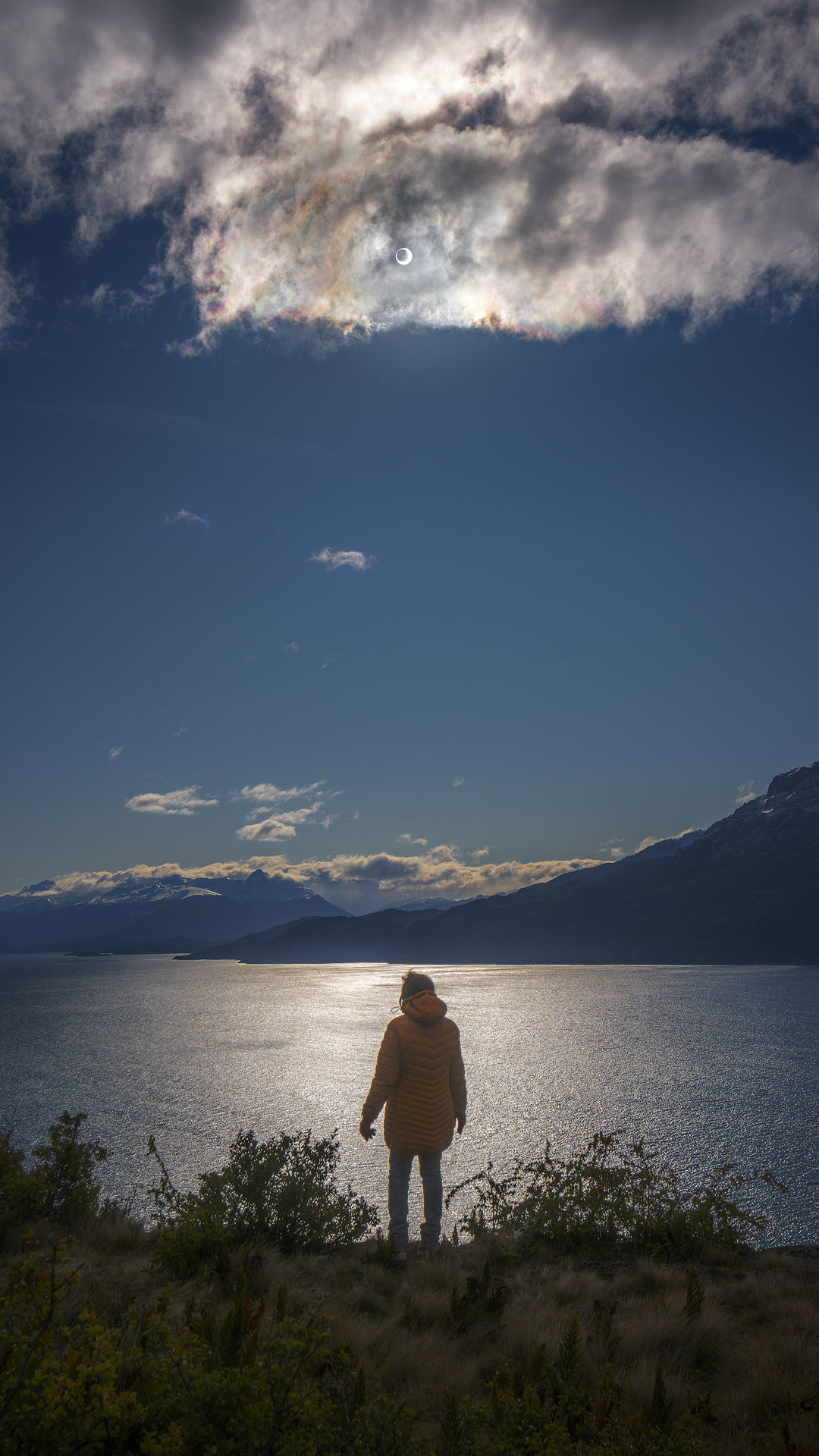08. October 2024
智利 Patagonia 天頂 ê 日環食

探索宇宙1!逐工會揀一幅無仝款 ê 影像抑是相片,𤆬你熟似咱這个迷人 ê 宇宙,閣有專業天文學者2為你3解說4。
- 原始文章:Annular Eclipse over Patagonia
- 影像來源 kah 版權:Alexis Trigo
- 天文相簿:2024 年 10 月 ê 日環食
- 台文翻譯:An-Li Tsai (NSYSU)
[漢羅] 智利 Patagonia 天頂 ê 日環食
你有看著日頭無? 好!按呢你敢會當 kā 咱解說講,是按怎日頭中央有一粒大烏斑? 這个烏斑就是 月球,伊若是 行到太陽內底,咱就會 kā 這个現象叫做 日環食,抑是金環日食。 這个現象發生 tī 頂禮拜 地球 南半球 一條狹狹 ê 月球烏影 下底。 這張相片是 tī 智利 Patagonia 翕--ê。 月球若是行到 離地球足倚、而且行到 kah 日頭排仝逝 ê 時陣,地球有一寡所在就看會著 日全食。 日環食 比 日全食 較定定看著,毋過 月球 會離咱 地球 愈來愈遠。 閣過 10 億年,月球 ê 軌道就離咱 地球 無夠近,到時就 看無 日全食 矣。
[POJ] Tì-lī Patagonia thiⁿ-téng ê Ji̍t-khoân-si̍t
Lí ū khòaⁿ-tio̍h ji̍t-thâu bô? Hó! Án-ne lí kám ē-tàng kā lán kái-soeh kóng, sī-án-chóaⁿ ji̍t-thâu tiong-ng ū chi̍t-lia̍p tōa o͘-pan? Chit-ê o͘-pan tio̍h-sī Goe̍h-kiû, i nā-sī kiâⁿ kàu Thài-iông lāi-té, lán to̍h ē kā chit-ê hiān-siōng kiò-chò ji̍t-khoân-si̍t, ia̍h-sī kim-khoân ji̍t-si̍t. Chit-ê hiān-siōng hoat-seng tī téng-lé-pài Tē-kiû lâm-pòaⁿ-kiû chi̍t tiâu e̍h-e̍h ê Goe̍h-kiû o͘-iáⁿ ē-té. Chit-tiuⁿ siòng-phìⁿ sī tī Tì-lī Patagonia hip--ê. Goe̍h-kiû nā-sī kiâⁿ kàu lī Tē-kiû chiok óa, jî-chhiáⁿ kiâⁿ kàu kah ji̍t-thâu pâi kāng chōa ê sî-chūn, Tē-kiû ū chi̍t-kóa só͘-chāi to̍h khòaⁿ-ē-tio̍h ji̍t-choân-si̍t. Ji̍t-khoân-si̍t pí ji̍t-choân-si̍t khah tiāⁿ-tiāⁿ khòaⁿ--tio̍h, m̄-koh Goe̍h-kiû ē lī lán Tē-kiû lú-lâi-lú hn̄g. Koh kòe 10 ek nî, Goe̍h-kiû ê kúi-tō to̍h lī lán Tē-kiû bô-kàu kīn, kàu-sî to̍h khòaⁿ-bô ji̍t-choân-si̍t--ah.
[KIP] Tì-lī Patagonia thinn-tíng ê Ji̍t-khuân-si̍t
Lí ū khuànn-tio̍h ji̍t-thâu bô? Hó! Án-ne lí kám ē-tàng kā lán kái-sueh kóng, sī-án-tsuánn ji̍t-thâu tiong-ng ū tsi̍t-lia̍p tuā oo-pan? Tsit-ê oo-pan tio̍h-sī Gue̍h-kiû, i nā-sī kiânn kàu Thài-iông lāi-té, lán to̍h ē kā tsit-ê hiān-siōng kiò-tsò ji̍t-khuân-si̍t, ia̍h-sī kim-khuân ji̍t-si̍t. Tsit-ê hiān-siōng huat-sing tī tíng-lé-pài Tē-kiû lâm-puànn-kiû tsi̍t tiâu e̍h-e̍h ê Gue̍h-kiû oo-iánn ē-té. Tsit-tiunn siòng-phìnn sī tī Tì-lī Patagonia hip--ê. Gue̍h-kiû nā-sī kiânn kàu lī Tē-kiû tsiok uá, jî-tshiánn kiânn kàu kah ji̍t-thâu pâi kāng tsuā ê sî-tsūn, Tē-kiû ū tsi̍t-kuá sóo-tsāi to̍h khuànn-ē-tio̍h ji̍t-tsuân-si̍t. Ji̍t-khuân-si̍t pí ji̍t-tsuân-si̍t khah tiānn-tiānn khuànn--tio̍h, m̄-koh Gue̍h-kiû ē lī lán Tē-kiû lú-lâi-lú hn̄g. Koh kuè 10 ik nî, Gue̍h-kiû ê kuí-tō to̍h lī lán Tē-kiû bô-kàu kīn, kàu-sî to̍h khuànn-bô ji̍t-tsuân-si̍t--ah.
[English] Annular Eclipse over Patagonia
Can you find the Sun? OK, but can you explain why there’s a big dark spot in the center? The spot is the Moon, and the impressive alignment shown, where the Moon lines up inside the Sun, is called an annular solar eclipse. Such an eclipse occurred just last week and was visible from a thin swath mostly in Earth's southern hemisphere. The featured image was captured from Patagonia, Chile. When the Moon is significantly closer to the Earth and it aligns with the Sun, a total solar eclipse is then visible from parts of the Earth. Annular eclipses are slightly more common than total eclipses, but as the Moon moves slowly away from the Earth, before a billion more years, the Moon's orbit will no longer bring it close enough for a total solar eclipse to be seen from anywhere on Earth.
詞彙學習
| 漢羅 | POJ | KIP | 華語 | English |
|---|---|---|---|---|
| 日環食 | ji̍t-khoân-si̍t | ji̍t-khuân-si̍t | 日環食 | annular eclipse |
| 金環日食 | kim-khoân ji̍t-si̍t | kim-khuân ji̍t-si̍t | 日環食 | annular eclipse |
| 日全食 | ji̍t-choân-si̍t | ji̍t-chuân-si̍t | 日全食 | total solar eclipse |
| 南半球 | lâm-pòaⁿ-kiû | lâm-puànn-kiû | 南半球 | southern hemisphere |